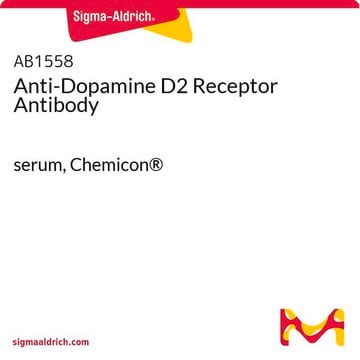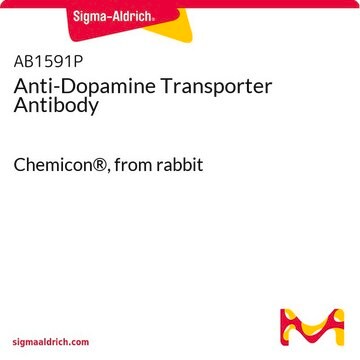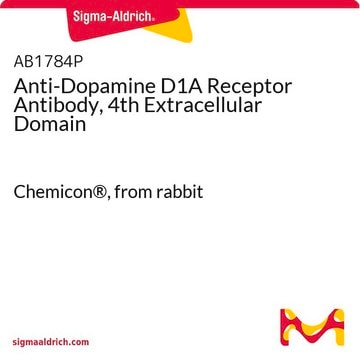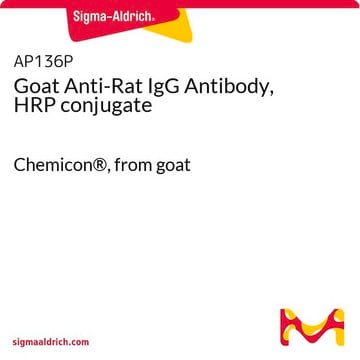MAB5292
Anti-Dopamine D1B Receptor Antibody, clone SG4-D1B
clone SG4-D1B, Chemicon®, from mouse
Synonym(s):
Dopamine D5 Receptor
About This Item
Recommended Products
biological source
mouse
antibody form
purified immunoglobulin
antibody product type
primary antibodies
clone
SG4-D1B, monoclonal
species reactivity
mouse, rat
should not react with
human
manufacturer/tradename
Chemicon®
technique(s)
immunohistochemistry: suitable
western blot: suitable
isotype
IgG1
NCBI accession no.
UniProt accession no.
shipped in
wet ice
target post-translational modification
unmodified
Gene Information
human ... DRD5(1816)
Specificity
Immunogen
Application
Neuroscience
Neurotransmitters & Receptors
Immunohistochemistry
Optimal working dilutions must be determined by the end user.
SUGGESTED WESTERN BLOT PROTOCOL
Solutions
10X Transfer buffer 1 liter
Tris 115.3 gm
Glycine 24.2 gm
[SDS 4 gm (may be omitted)]
For a 1X working solution: 1 liter
mix 700 mL water
200 mL
MeOH100 mL
10X Transfer
TBSTstock 1 liter1M
Tris pH 7.5 10 mL
5 M NaCl 30 mL
10% Tween-20 5 Ml
1. Run SDS-PAGE gel as desired.
2. Soak PVDF membrane (ImmobilonP from Millipore) in 100% methanol for 1-2 minutes to wet the membrane.
3. Soak membrane in transfer buffer (see below) until ready to set up blot (>15 min) transfer.
4. Assemble gel-transfer sandwich with the blot toward the positive electrode.
5. Transfer protein from gel to membrane at 100 volts for 1-2 hours for small molecular weight proteins or 65 mA for 16 hours (overnight) for complete transfer of higher molecular weight proteins.
6. Stain the transferred bands with Chemicon BLOT-FastStain (Catalog Number 2076).
7. Destain with deionized water.
8. Block with 5% non-fat milk (Marvel or Carnation) in water, overnight at 4°C. The non-fat milk should be dissolved freshly, centrifuged 10,000 rpm for 10 min, and filtered through glass filter (Gelman Acrodisc).
9. Incubation with first antibody overnight with rocking at 4°C in blocking solution. Optimal working dilutions and incubation time will need to be determined by the end user.
10. Wash at least 3 x 5 min. with TBST. From this stage, azide should be omitted.
11. Incubation with the secondary antibody (HRP-conjugated goat anti-mouse antibody, for example Chemicon Catalog Number AP124P, diluted appropriately) 1 h at room temperature.
12. Wash at least 3 x 5 min. with TBST.
13. Perform ECL with commercial kit (femtoLUCENT, Chemicon Catalog Number 2078).
Linkage
Physical form
Storage and Stability
Other Notes
Legal Information
Disclaimer
Not finding the right product?
Try our Product Selector Tool.
Storage Class Code
10 - Combustible liquids
WGK
WGK 2
Flash Point(F)
Not applicable
Flash Point(C)
Not applicable
Certificates of Analysis (COA)
Search for Certificates of Analysis (COA) by entering the products Lot/Batch Number. Lot and Batch Numbers can be found on a product’s label following the words ‘Lot’ or ‘Batch’.
Already Own This Product?
Find documentation for the products that you have recently purchased in the Document Library.
Our team of scientists has experience in all areas of research including Life Science, Material Science, Chemical Synthesis, Chromatography, Analytical and many others.
Contact Technical Service








